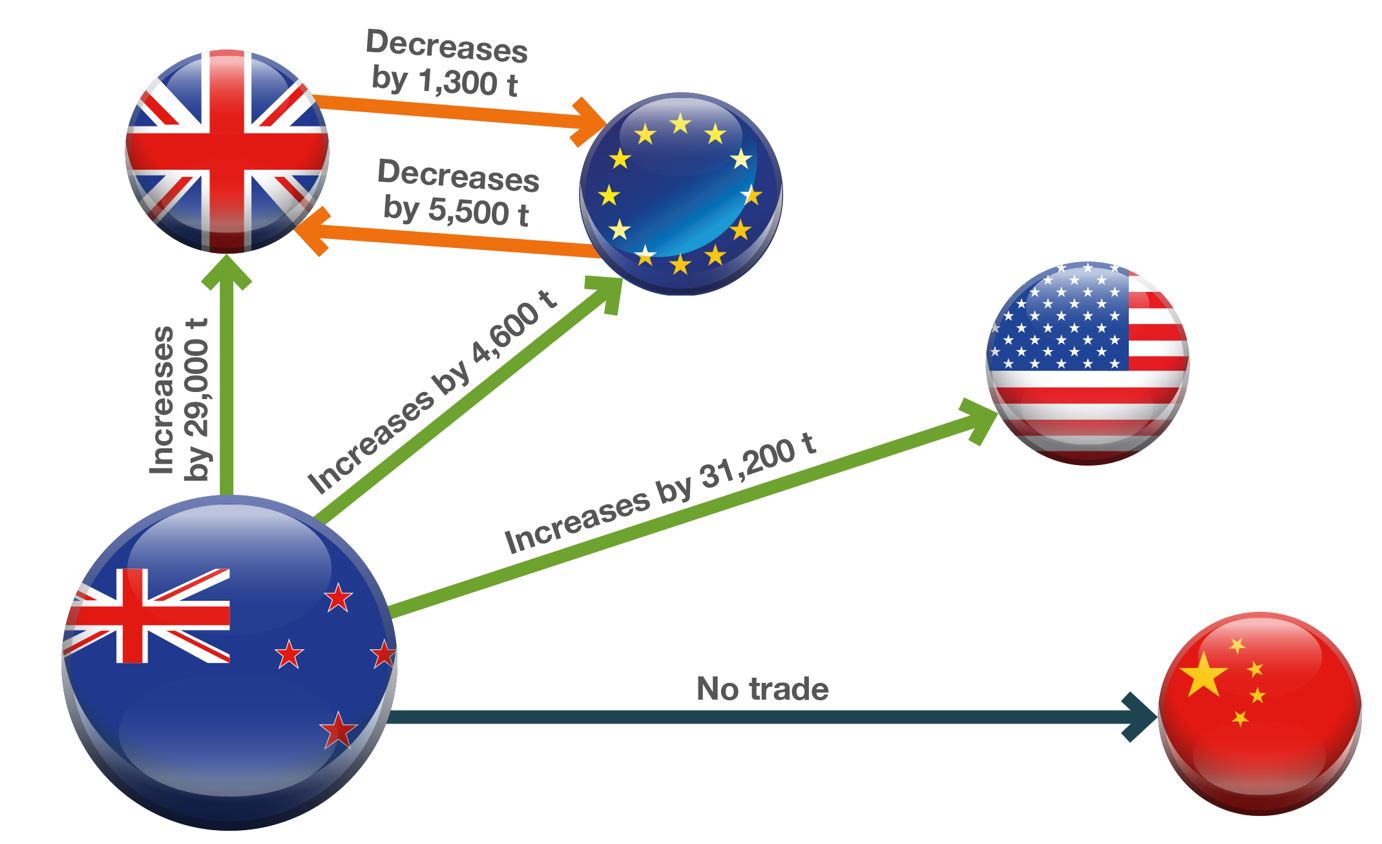Lamb: modelling the impact of a UK-New Zealand trade deal
Thursday, 11 August 2022
For lamb, the impact of the UK-New Zealand trade deal was examined looking at the changes expected after the deal comes into force. This aspect of the modelling work assumes all other circumstances remain the same. We also looked at the potential impact if, in the future, China banned imports of lamb from China.
Key points for lamb sector:
- The model suggests that New Zealand lamb exports to the UK will increase by around 5,800 tonnes which equates to an increase 14% in percentage terms on the baseline used within the model
- Total UK imports are expected to increase about 8% or 4,800 tonnes, with the increase from New Zealand partially offset by reduced imports from the EU
- Results show that changes to production and price are relatively small, but it is clear the impacts are negative from a farmer’s perspective in the UK, whereas they benefit New Zealand farmers
These results assume that China/New Zealand trade relations stay the same. If the relationship was to break down, and China imposed tariffs on New Zealand lamb imports, or banned them altogether, there would be much more lamb on the global marketplace looking for a home. We have modelled these scenarios, and results show New Zealand exports to the UK rising by around 13,000 tonnes (31%) if China imposed a 25% tariff on NZ lamb imports and 29,000 tonnes (69%) if there was an outright ban.
For lamb, the chosen network consists of the UK, New Zealand, EU, USA and China. The EU is a significant exporter and importer of sheep meat and is the main market for UK exports. China and the USA both act as a major importers of sheep meat, while neither export any lamb of considerable value.
Figure 1 shows changes in trade within the network. The model shows an increase of imports from New Zealand to the UK of around 14% (5,800 t), whereas imports from the EU drop by 8% (1,000 t).
From a New Zealand perspective, exports to the UK rise due to a number of factors. The model predicts that New Zealand will increase its exports by diverting some of its existing exports (notably from China) coupled with a small increase in production.
The model has predicted that New Zealand’s production of lamb will increase by over 2,000 tonnes. While this is a small increase in percentage terms, in reality it is unlikely as sheep numbers in New Zealand have been falling. On this basis, the amount of lamb/sheepmeat exported to the UK from New Zealand once the FTA is in force, is likely to be less than 5,800 tonnes.
Some may question why imports from New Zealand increase at all, given they already benefit from a 0% tariff rate quota (TRQ) which hasn’t been filled for a number of years. The reason is that we expect the new Free Trade Agreement (FTA) will reduce the current level of non-tariff barriers, in both directions. This will lead to reduced costs for New Zealand exporters supplying the UK market. Whilst non-tariff barriers (NTBs) are notoriously difficult to quantify, AHDB has funded research into this topic previously[1]. Drawing from this evidence we have assumed in the modelling that they currently add an effective 1.3% to the cost of New Zealand lamb exports to the UK.
Figure 1. Network showing main changes in trade flows

Source: AHDB/Harper Adams University
When assessing the overall effect of these changes on the UK farmgate price, we can see the impact is relatively small (<-0.5%), and there is also expected to be a small drop in UK production. In comparison, there are small positive impacts for New Zealand’s farmers for both of these metrics. Table 1 details what effect this change in trading patterns has on domestic production, prices and the total amount of lamb available in the domestic marketplace.
Table 1. Detailed results for lamb
|
UK |
New Zealand |
|
|
Domestic production |
<-0.5% (-300 t) |
+1% (2,350 t) |
|
Price paid to producers |
<-0.5% |
<+0.5% |
|
Total lamb sold in the domestic market (incl imports) |
+1.6% (4,500 t) |
<-0.5% (<200 t) |
|
Retail price |
-1% |
<+0.5% |
Source: AHDB/Harper Adams University
Further considerations
There are still a number of caveats to these results. Like other economic models, the trade network model is not a prediction or forecast and assumes all other things remain equal.
For example, the model assumes that New Zealand retains its current preferential trading arrangements with China. If these were to change, we would expect the New Zealand product currently traded with China to be diverted elsewhere in the global marketplace, including the UK.
In a scenario where China imposes a 25% tariff on New Zealand lamb imports the model shows that its exports to the UK would increase by 13,000 tonnes (31%) rather than the 5,800 tonnes (14%) discussed above. If China decided to ban New Zealand lamb imports altogether, the model predicts that New Zealand lamb exports to the UK would increase by 29,000 tonnes (69%).
Figure 2. Main changes in trade flows within network if China banned all New Zealand lamb imports
Source: AHDB/Harper Adams University
In both of these scenarios, New Zealand also diverts more lamb to the EU and US markets. The knock-on effect of this on the UK is that UK exports to the EU fall by under 400 tonnes (25% scenario) and 1,300 tonnes (outright ban scenario) due to increased competition from New Zealand for the EU market.
Like other economic models, the trade network model treats all products in a category as homogenous. In reality, we know that there are differing levels of demand for different cuts of lamb in different markets. The model treats all cuts as the same and therefore the impact of carcase balance must be considered alongside the results. As such our interpretation considers the modelling results within the context of the other analysis and findings.
Further details for the modelling results shown for each sector:




